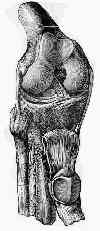- Radiographs:
- Anatomy:
- varus or valgus angulation of arthritic knee usually results from 3 components:
- geometric alignment of femur & tibia;
- narrowing or loss of bone & cartilage in one compartment;
- widening of other compartment's joint space because of slack ligamentous and soft-tissue structures;
- detected by measuring difference between involved knee and the opposite, uninvolved knee;
- each millimeter of excessive joint space separation causes an apparent 1 deg of angular deformity on weightbearing x-ray;
- if widening is not taken into consideration, an excessive lateral tibial wedge may be removed, and therefore malalignment may be
overcorrected;
- Planning the Osteotomy:
- management of fibula:
- closing-wedge osteotomy:
- most commonly performed HTO procedure;
- may be contra-indicated when the affected leg is shorter than the unaffected leg;
- opening wedge osteotomy:
- requires bone grafting, w/ delay in mobilizing knee & possibility of collapse of graft & loss of correction;
- indicated when the affected side is shorter than the non affected side;
- osteotomy site:
- osteotomy distal to tibial tubercle is more slow to heal than osteotomy above the tubercle;
- osteotomy proximal to tibial tubercle;
- quadriceps can exert compressive effect at osteotomy site;
- cancellous bone allows faster healing;
- osteotomy is generally performed 2 cm distal to joint line;
- more proximal resection causes proximal frag to be too thin & at risk for intraoperative fracture or avascular necrosis;
- osteotomy that is too distal disrupts extensor mech at tibial tubercle;
- size of the wedge:
- see: radiographs for HTO:
- measured by transposing measurements from the radiograph to the tibia and by accurately measuring the base of the wedge.
- as a rule of thumb, removing 1 mm of tibial wedge will provide 1 deg of correction;
- this is precisely true for a tibia which is 56 mm wide
- references:
- Serial Assessment of Weight-Bearing Lower Extremity Alignment Radiographs After Open-Wedge High Tibial Osteotomy
- Standing radiographs cannot determine the correction in high tibial osteotomy.
Preoperative planning for high tibial osteotomy. The effect of lateral tibiofemoral separation and tibiofemoral length.
Standing radiographs cannot determine the correction in high tibial osteotomy.
High Tibial Valgus Osteotomy: Closing, Opening or Combined? Patellar Height as a Determining Factor
.....................................................................................................................................................................................................................................................................................................................
Original Text by Clifford R. Wheeless, III, MD.
Last updated by Clifford R. Wheeless, III, MD on Sunday, April 26, 2015 11:41 am

